American biotechnology has turned Argentina into the world’s third-largest soybean producer, but the chemicals powering the boom aren’t confined to soy and cotton and corn fields. They routinely contaminate homes and classrooms and drinking water. A growing chorus of doctors and scientists is warning that their uncontrolled use could be responsible for the increasing number of health problems turning up in hospitals across the South American nation. In the heart of Argentina’s soybean business, house-to-house surveys of 65,000 people in farming communities found cancer rates two to four times higher than the national average, as well as higher rates of hypothyroidism and chronic respiratory illnesses. Associated Press photographer Natacha Pisarenko spent months documenting the issue in farming communities across Argentina.
Most provinces in Argentina forbid spraying pesticides and other agrochemicals next to homes and schools, with bans ranging in distance from 50 meters to as much as several kilometers from populated areas. The Associated Press found many cases of soybeans planted only a few feet from homes and schools, and of chemicals mixed and loaded onto tractors inside residential neighborhoods. In the last 20 years, agrochemical spraying has increased eightfold in Argentina- from 9 million gallons in 1990 to 84 million gallons today. Glyphosate, the key ingredient in Monsanto’s Round Up products, is used roughly eight to ten times more per acre than in the United States. Yet Argentina doesn’t apply national standards for farm chemicals, leaving rule-making to the provinces and enforcement to the municipalities. The result is a hodgepodge of widely ignored regulations that leave people dangerously exposed.
via denverpost.com

In this March 29, 2013, photo, former farmworker Fabian Tomasi, 47, shows the condition of his emaciated body as he stands inside his home in Basavilbaso, in Entre Rios province, Argentina. Tomasi’s job was to keep the crop dusters flying by quickly filling their tanks but he says he was never trained to handle pesticides. Now he is near death from polyneuropathy.
BASAVILBASO, Argentina (AP) — Argentine farmworker Fabian Tomasi was never trained to handle pesticides. His job was to keep the crop-dusters flying by filling their tanks as quickly as possible, although it often meant getting drenched in poison.
Now, at 47, he’s a living skeleton, so weak he can hardly swallow or go to the bathroom on his own.
Schoolteacher Andrea Druetta lives in Santa Fe Province, the heart of Argentina’s soy country, where agrochemical spraying is banned within 500 meters (550 yards) of populated areas. But soy is planted just 30 meters (33 yards) from her back door. Her boys were showered in chemicals recently while swimming in the backyard pool.
After Sofia Gatica lost her newborn to kidney failure, she filed a complaint that led to Argentina’s first criminal convictions for illegal spraying. But last year’s verdict came too late for many of her 5,300 neighbors in Ituzaingo Annex. A government study there found alarming levels of agrochemical contamination in the soil and drinking water, and 80 percent of the children surveyed carried traces of pesticide in their blood.
American biotechnology has turned Argentina into the world’s third-largest soybean producer, but the chemicals powering the boom aren’t confined to soy and cotton and corn fields.
The Associated Press documented dozens of cases around the country where poisons are applied in ways unanticipated by regulatory science or specifically banned by existing law. The spray drifts into schools and homes and settles over water sources; farmworkers mix poisons with no protective gear; villagers store water in pesticide containers that should have been destroyed.
Now doctors are warning that uncontrolled pesticide applications could be the cause of growing health problems among the 12 million people who live in the South American nation’s vast farm belt.
In Santa Fe, cancer rates are two times to four times higher than the national average. In Chaco, birth defects quadrupled in the decade after biotechnology dramatically expanded farming in Argentina.
“The change in how agriculture is produced has brought, frankly, a change in the profile of diseases,” says Dr. Medardo Avila Vazquez, a pediatrician and neonatologist who co-founded Doctors of Fumigated Towns, part of a growing movement demanding enforcement of agricultural safety rules. “We’ve gone from a pretty healthy population to one with a high rate of cancer, birth defects, and illnesses seldom seen before.”
A nation once known for its grass-fed beef has undergone a remarkable transformation since 1996, when the St. Louis-based Monsanto Co. promised that adopting its patented seeds and chemicals would increase crop yields and lower pesticide use. Today, Argentina’s entire soy crop and nearly all its corn and cotton are genetically modified, with soy cultivation alone tripling to 47 million acres (19 million hectares).
Agrochemical use did decline at first, then it bounced back, increasing ninefold from 9 million gallons (34 million liters) in 1990 to more than 84 million gallons (317 million liters) today as farmers squeezed in more harvests and pests became resistant to the poisons. Overall, Argentine farmers apply an estimated 4.3 pounds of agrochemical concentrate per acre, more than twice what U.S. farmers use, according to an AP analysis of government and pesticide industry data.
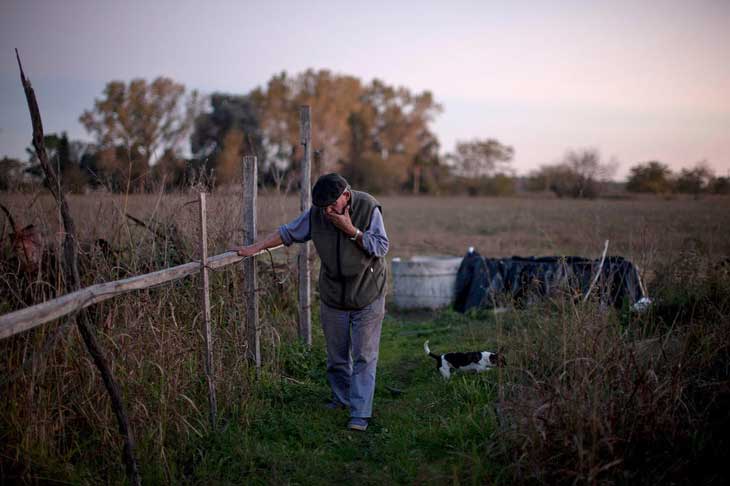
In this April 16, 2013, photo, Felix San Roman walks on his property in Rawson, in Buenos Aires province, Argentina. San Roman says that when he complained about clouds of chemicals drifting into his yard, the sprayers beat him up, fracturing his spine and knocking out his teeth. “This is a small town where nobody confronts anyone, and the authorities look the other way,” San Roman said. “All I want is for them to follow the existing law, which says you can’t do this within 1,500 meters. Nobody follows this. How can you control it?” (AP Photo/Natacha Pisarenko)
Glyphosate, the key ingredient in Monsanto’s popular Roundup brand of pesticides, is one of the world’s most widely used weed killers. It has been determined to be safe, if applied properly, by many regulatory agencies, including those of the United States and European Union.
On May 1, the U.S. Environmental Protection Agency even raised the allowable levels of glyphosate residues in food, concluding that based on studies presented by Monsanto, “there is a reasonable certainty that no harm will result to the general population or to infants and children from aggregate exposure.”
Argentina’s 23 provinces take the lead in regulating farming, and rules vary.
Spraying is banned within 3 kilometers (1.9 miles) of populated areas in some provinces and as little as 50 meters (55 yards) in others. About one-third of the provinces set no limits at all, and most lack detailed enforcement policies.
A federal environmental law requires applicators of toxic chemicals to suspend or cancel activities that threaten public health, “even when the link has not been scientifically proven,” and “no matter the costs or consequences,” but it has never been applied to farming, the auditor general found last year.
In response to soaring complaints, President Cristina Fernandez ordered a commission in 2009 to study the impact of agrochemical spraying on human health. Its initial report called for “systematic controls over concentrations of herbicides and their compounds … such as exhaustive laboratory and field studies involving formulations containing glyphosate as well as its interactions with other agrochemicals as they are actually used in our country.”
But the commission hasn’t met since 2010, the auditor general found.
Government officials insist the problem is not a lack of research, but misinformation that plays on people’s emotions.
“I’ve seen countless documents, surveys, videos, articles in the news and in universities, and really our citizens who read all this end up dizzy and confused,” Agriculture Secretary Lorenzo Basso said. “I think we have to publicize the commitment that Argentina has to being a food producer. Our model as an exporting nation has been called into question. We need to defend our model.”
In a written statement, Monsanto spokesman Thomas Helscher said the company “does not condone the misuse of pesticides or the violation of any pesticide law, regulation, or court ruling.”
“Monsanto takes the stewardship of products seriously and we communicate regularly with our customers regarding proper use of our products,” Helscher said.
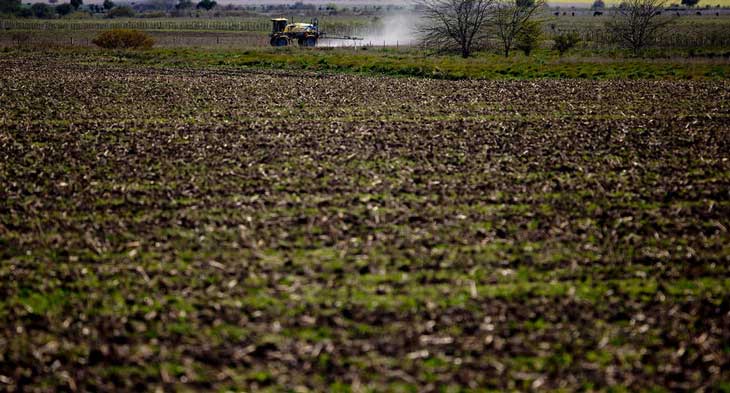
In this Sept. 24, 2013, photo, a tractor known as a “mosquito” dusts a field near Parana, in the Entre Rios province, Argentina. Most provinces forbid spraying next to homes and schools, ranging in distance from 50 meters to as much as several kilometers from populated areas. But The Associated Press found many cases of soybeans planted only a few feet from homes and schools, and of chemicals mixed and loaded onto tractors inside residential neighborhoods. (AP Photo/Natacha Pisarenko)
Argentina was among the earliest adopters of the new biotech farming model promoted by Monsanto and other U.S. agribusinesses.
Instead of turning the topsoil, spraying pesticides and then waiting until the poison dissipates before planting, farmers sow the seeds and spray afterward without harming crops genetically modified to tolerate specific chemicals.
This “no-till” method takes so much less time and money that farmers can reap more harvests and expand into land not worth the trouble before.
But pests develop resistance, even more so when the same chemicals are applied to genetically identical crops on a vast scale.
So while glyphosate is one of the world’s safest herbicides, farmers now use it in higher concentrates and mix in much more toxic poisons, such as 2,4,D, which the U.S. military used in “Agent Orange” to defoliate jungles during the Vietnam War.
In 2006, a division of Argentina’s agriculture ministry recommended adding caution labels urging that mixtures of glyphosate and more toxic chemicals be limited to “farm areas far from homes and population centers.” The recommendation was ignored, according to the federal audit.
The government relies on industry research approved by the EPA, which said May 1 that “there is no indication that glyphosate is a neurotoxic chemical and there is no need for a developmental neurotoxicity study.”
Molecular biologist Dr. Andres Carrasco at the University of Buenos Aires says the burden from the chemical cocktails is worrisome, but even glyphosate alone could spell trouble for human health. He found that injecting a very low dose of glyphosate into embryos can change levels of retinoic acid, causing the same sort of spinal defects in frogs and chickens that doctors increasingly are registering in communities where farm chemicals are ubiquitous.
This acid, a form of vitamin A, is fundamental for keeping cancers in check and triggering genetic expression, the process by which embryonic cells develop into organs and limbs.
“If it’s possible to reproduce this in a laboratory, surely what is happening in the field is much worse,” Carrasco said. “And if it’s much worse, and we suspect that it is, what we have to do is put this under a magnifying glass.”
His findings, published in the journal Chemical Research in Toxicology in 2010, were rebutted by Monsanto, which said the results “are not surprising given their methodology and unrealistic exposure scenarios.”
Monsanto said in response to AP’s questions that chemical safety tests should only be done on live animals, and that injecting embryos is “less reliable and less relevant for human risk assessments.”
“Glyphosate is even less toxic than the repellent you put on your children’s skin,” said Pablo Vaquero, Monsanto’s corporate affairs director in Buenos Aires. “That said, there has to be a responsible and good use of these products because in no way would you put repellent in the mouths of children and no environmental applicator should spray fields with a tractor or a crop-duster without taking into account the environmental conditions and threats that stem from the use of the product.”
Out in the fields, warnings are widely ignored.
For three years, Tomasi was routinely exposed to chemicals as he pumped pesticides into the tanks of crop-dusters. Now he’s near death from polyneuropathy, a debilitating neurological disorder, which has left him wasted and shriveled.
“I prepared millions of liters of poison without any kind of protection, no gloves, masks or special clothing,” he said. “I didn’t know anything. I only learned later what it did to me, after contacting scientists.”
“The poison comes in liquid concentrates, in containers with lots of precautions to take when applying it,” Tomasi explained. “But nobody takes precautions.”
With soybeans selling for about $500 a ton, growers plant where they can, often disregarding Monsanto’s guidelines and provincial law by spraying with no advance warning, and even in windy conditions.
In Entre Rios, teachers reported that sprayers failed to respect 50-meter (55-yard) limits at 18 schools, dousing 11 during class. Five teachers filed police complaints this year.
READ MORE HERE

In this April 1, 2013 photo, Aixa Cano, 5, who has hairy moles all over her body that doctors can’t explain, sits on a stoop outside her home in Avia Terai, in Chaco province, Argentina. Although it’s nearly impossible to prove, doctors say Aixa’s birth defect may be linked to agrochemicals. In Chaco, children are four times more likely to be born with devastating birth defects since biotechnology dramatically expanded farming in Argentina. Chemicals routinely contaminate homes, classrooms and drinking water. (AP Photo/Natacha Pisarenko)
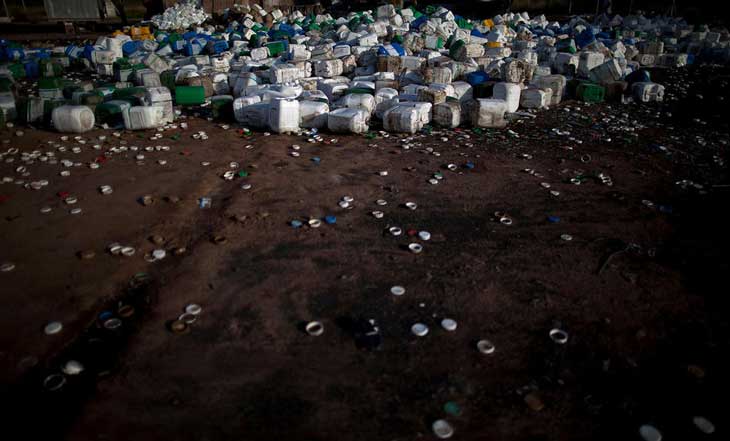
In this May 2, 2013 photo, empty agrochemical containers including Monsanto’s Round Up products lay discarded at a recycling center in Quimili, Santiago del Estero province, Argentina. Instead of a lighter chemical burden in Argentina, agrochemical spraying has increased eightfold, from 9 million gallons in 1990 to 84 million gallons today. Glyphosate, the key ingredient in Monsanto’s Round Up products, is used roughly eight to ten times more per acre than in the United States. Yet Argentina doesn’t apply national standards for farm chemicals, leaving rule-making to the provinces and enforcement to the municipalities. The result is a hodgepodge of widely ignored regulations that leave people dangerously exposed. (AP Photo/Natacha Pisarenko)
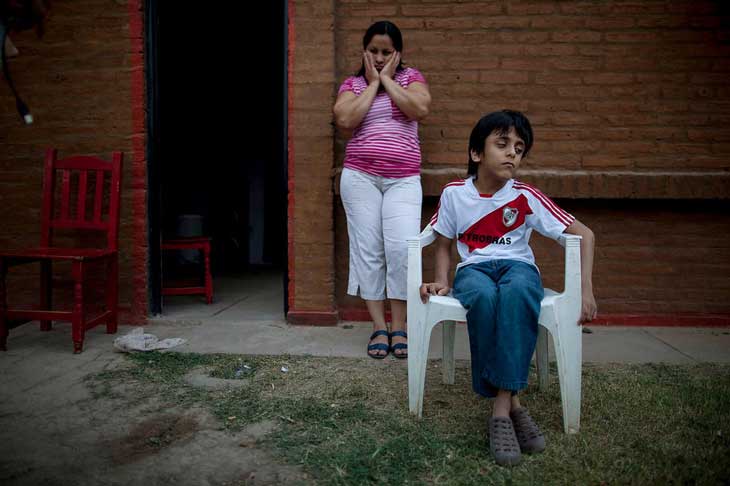
In this April 1, 2013, photo, Silvia Alvarez leans against her red brick home while keeping an eye on her son, Ezequiel Moreno, who was born with hydrocephalus, in Gancedo, in Chaco province, Argentina. Alvarez blames continuous exposure to agrochemical spraying for two miscarriages and her son’s health problems. Chaco provincial birth reports show that congenital defects quadrupled in the decade after genetically modified crops and their related agrochemicals arrived. (AP Photo/Natacha Pisarenko) #

In this March 31, 2013, photo, Erika, right, and her twin sister Macarena, who suffer from chronic respiratory illness, stand inside their home in Avia Terai, in Chaco province, Argentina. The twins’ mother, Claudia Sariski, whose home has no running water, says she doesn’t let her children drink from the discarded pesticide containers she keeps in her dusty backyard. But her chickens do, and she has no other water to wash the family’s clothes with. (AP Photo/Natacha Pisarenko) #
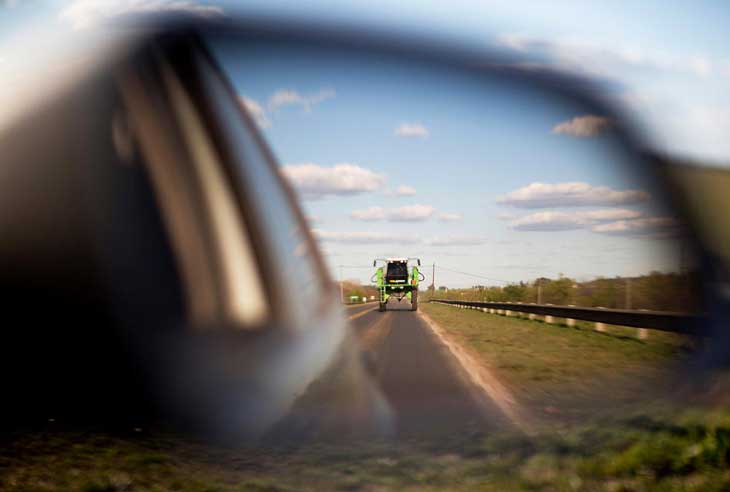
In this Sept. 24, 2013, photo, a tractor used for spraying agrochemicals is reflected in a car’s side view mirror on a road in Parana, in Entre Rios province, Argentina. Glyphosate represents two-thirds of all agrochemicals used in Argentina, but resistance to pesticides is forcing farmers to mix in other poisons such as 2,4,D, which the U.S. military used in

In this May 31, 2013 photo, girls use slingshots next to a biotech soybean plantation in Avia Terai, in Chaco province, Argentina. The country’s entire soybean crop and nearly all its corn and cotton have become genetically modified in the 17 years since St. Louis-based Monsanto Company promised huge yields with fewer pesticides using its patented seeds and chemicals. Instead, the agriculture ministry says agrochemical spraying has increased ninefold, from 9 million gallons in 1990 to 84 million gallons today. (AP Photo/Natacha Pisarenko)
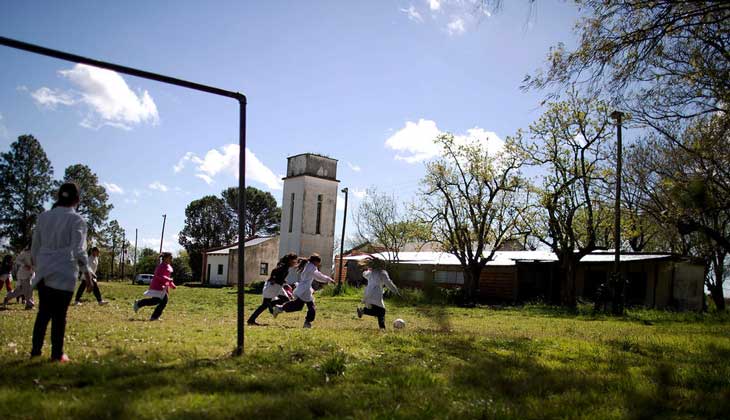
In this Sept. 24, 2013 photo, students play soccer during recess at a rural school near Concepcion del Uruguay, Entre Rios province, Argentina. Teachers say the farm that abuts their school yard has been illegally sprayed with pesticides, even during class time. In Entre Rios, teachers reported that sprayers failed to respect legally required 50 meter setbacks outside 18 schools, and doused 11 of them while students were in session. Five teachers have since filed police complaints. (AP Photo/Natacha Pisarenko)
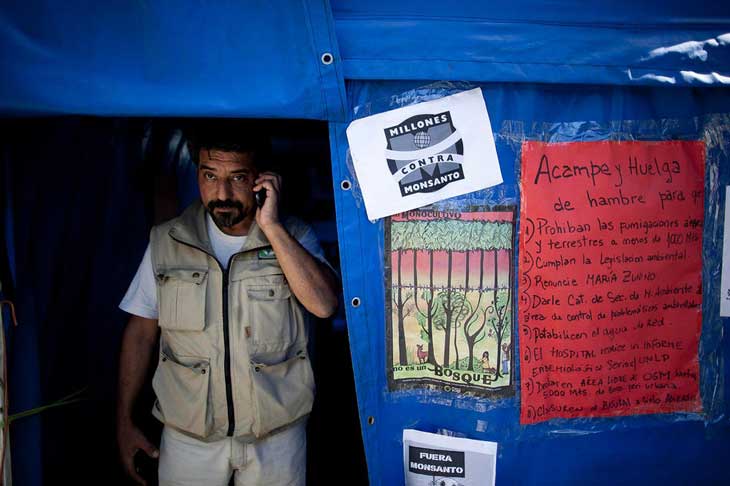
In this April 16, 2013, photo, activist Oscar Alfredo Di Vincensi talks on a cell phone inside his tent during his one-man hunger strike demanding that agrochemical spraying not be allowed within 1,000 meters of homes, in the main square of Alberti, in Buenos Aires province, Argentina. Earlier this year, Di Vincensi stood in a field waving a court order barring spraying within 1,000 meters of homes in his town of Alberti; a tractor driver doused him in pesticide. (AP Photo/Natacha Pisarenko)
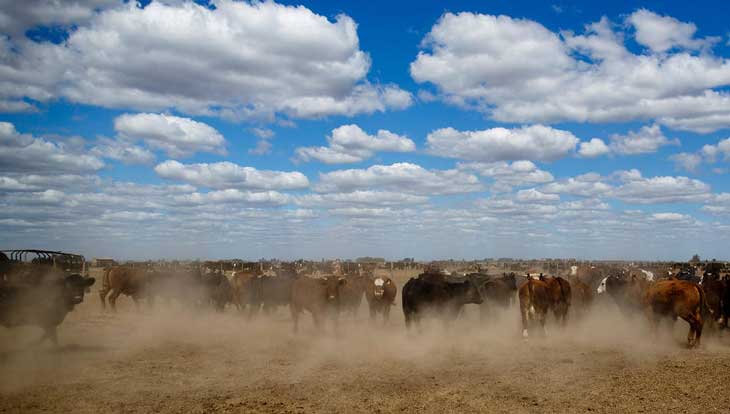
In this Sept. 25, 2013, photo, cattle are corralled near the town of Berabevu, in Santa Fe province, Argentina. As Argentine ranchers turn to higher-profit soybeans, formerly grass-fed cattle are fattened on corn and soy meal in feedlots. Argentina’s entire soy crop and nearly all its corn have become genetically modified in the 17 years since St. Louis-based Monsanto Company promised huge yields with fewer pesticides using its patented seeds and chemicals. Soy cultivation alone has tripled to 47 million acres, transforming a nation once known for its grass-fed cattle into the world’s third largest soybean producer. (AP Photo/Natacha Pisarenko)

In this March 31, 2013, photo, Erika, left, and her twin sister Macarena, who suffer from chronic respiratory illness, play in their backyard near recycled agrochemical containers filled with water that is used for flushing their toilet, feeding their chickens and washing their clothes, near the town of Avia Terai, in Chaco province, Argentina. The twins’ mother, Claudia Sariski, whose home has no running water, says she doesn’t let her children drink the water from the discarded pesticide containers. (AP Photo/Natacha Pisarenko)
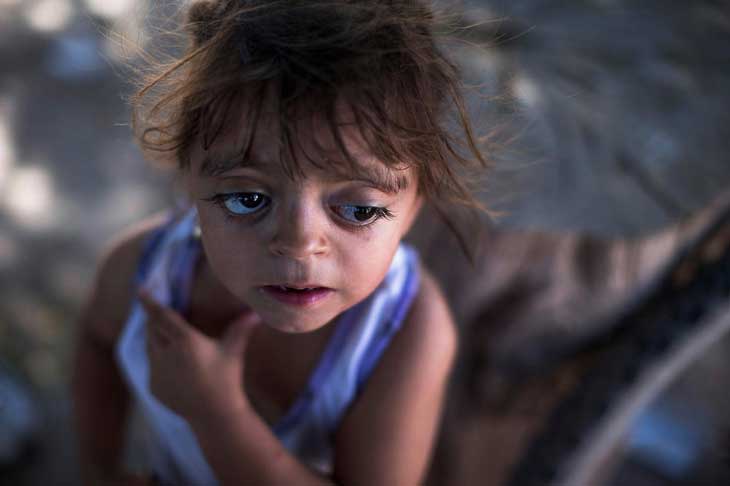
In this March 31, 2013, photo, Camila Veron, 2, born with multiple organ problems and severely disabled, stands outside her home in Avia Terai, in Chaco province, Argentina. Doctors told Camila’s mother, Silvia Achaval that agrochemicals may be to blame. It’s nearly impossible to prove that exposure to a specific chemical caused an individual’s cancer or birth defect, but doctors say these cases merit a rigorous government investigation. “They told me that the water made this happen, because they spray a lot of poison here,” said Achaval. (AP Photo/Natacha Pisarenko)

In this July 8, 2013 photo, Dr. Andres Carrasco, a molecular biologist at the University of Buenos Aires, pauses during an interview in Buenos Aires, Argentina. Carrasco found that injecting very low doses of glyphosate, a weed-killer, into embryos can change levels of retinoic acid, causing the same sort of spinal defects in frogs and chickens that doctors are increasingly registering in communities where farm chemicals are ubiquitous. (AP Photo/Natacha Pisarenko)
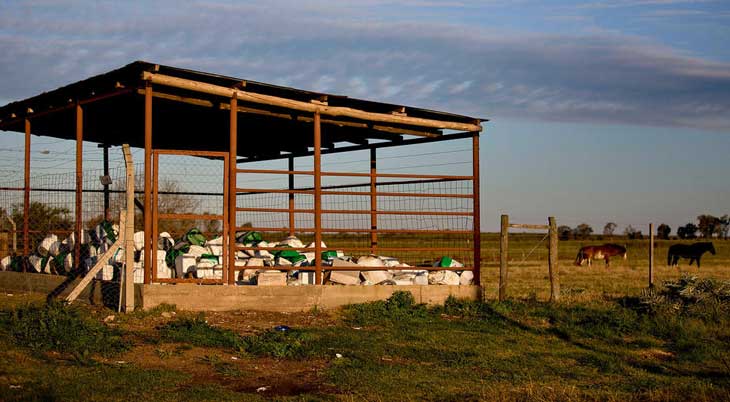
In this Sept. 23, 2013, photo, empty pesticide containers ready for recycling are collected inside an enclosure by the farming business association in Gualeguaychu, in Entre Rios province, Argentina. Widely ignored Argentine health minister guidelines recommend perforating empty containers to prevent reuse by residents. The association says the containers will be recycled into plastic tubing. (AP Photo/Natacha Pisarenko)

In this May 3, 2013, photo, students stand outside their rural school in Pozo del Toba, in Santiago del Estero province, Argentina. Most Argentine provinces limit how close spraying can be done in populated areas, with setbacks ranging from as little as 50 meters to as much as several kilometers. But The Associated Press found many cases of soybeans planted only a few feet from homes and schools, and chemicals mixed and loaded onto tractors inside residential neighborhoods. (AP Photo/Natacha Pisarenko)
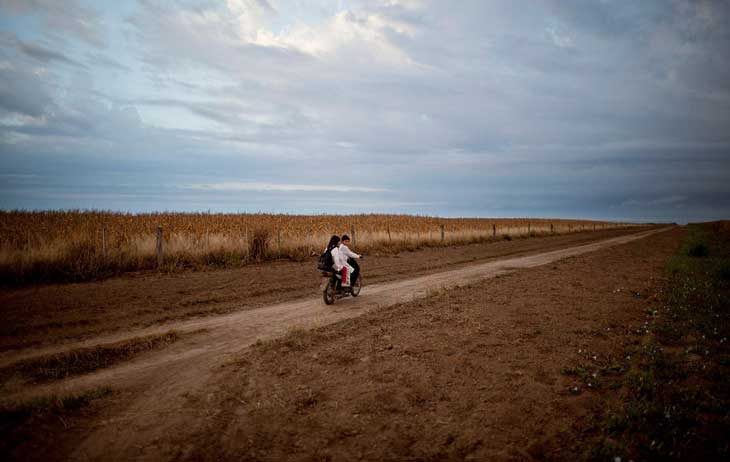
In this May 3, 2013, photo, students ride a motorbike past a field of biotech corn on their way to school in Pozo del Toba, Santiago del Estero province, Argentina. American biotechnology has turned Argentina into a commodities powerhouse, but the chemicals required aren’t confined to the fields, they routinely contaminate homes, classrooms and drinking water. Now a growing chorus of doctors and scientists is warning that uncontrolled spraying could be causing the health problems turning up in hospitals across the South American nation. (AP Photo/Natacha Pisarenko)
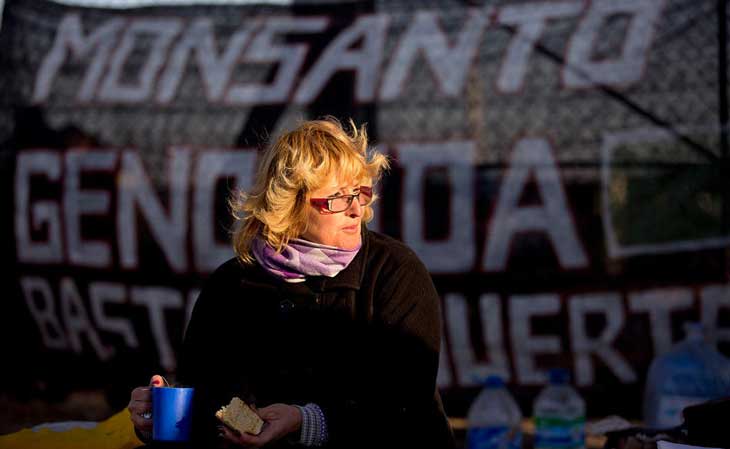
In this Sept. 26, 2013, photo, Sofia Gatica participates in a protest to block trucks from entering the site where Monsanto Company is building its largest Latin American seed production plant, in the town of Malvinas Argentinas, in Cordoba province, Argentina. The country’s entire soy crop and nearly all its corn and cotton have become genetically modified in the 17 years since the St. Louis-based company promised larger yields. Agrochemical spraying has increased eightfold. After Gatica’s newborn died of kidney failure, she filed a complaint in Cordoba province that led last year to Argentina’s first criminal convictions for illegal spraying. (AP Photo/Natacha Pisarenko)
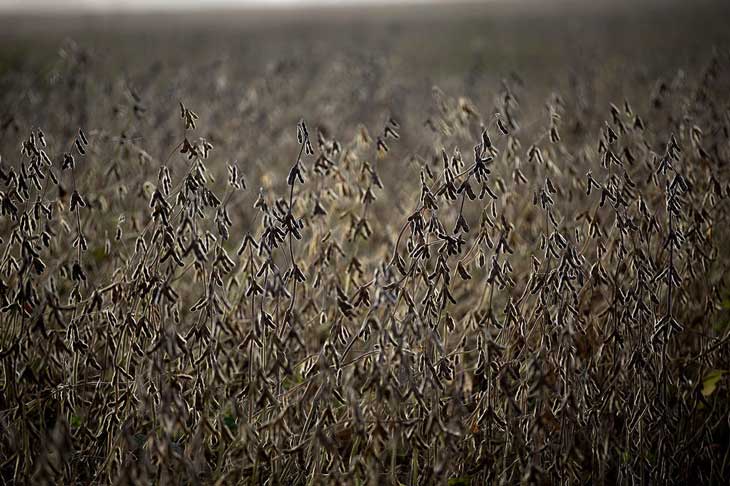
In this April 16, 2013 photo, soybeans ready for harvest are bathed in afternoon light near Rawson, in Buenos Aires province, Argentina. American biotechnology has turned Argentina into the world’s third-largest soybean producer, but the chemicals powering the boom aren’t confined to soy and cotton and corn fields. They routinely contaminate homes and classrooms and drinking water. A growing chorus of doctors and scientists is warning that their uncontrolled use could be responsible for the increasing number of health problems turning up in hospitals across the South American nation. (AP Photo/Natacha Pisarenko)

In this March 9, 2013, photo, residents gather to speak with Dr. Damian Verzenassi on health concerns they have about agrochemicals in the main square of Alvear, in Santa Fe province, Argentina. In the heart of Argentina’s soybean business, house-to-house surveys of 65,000 people in farming communities found cancer rates two to four times higher than the national average, as well as higher rates of hypothyroidism and chronic respiratory illnesses. (AP Photo/Natacha Pisarenko)